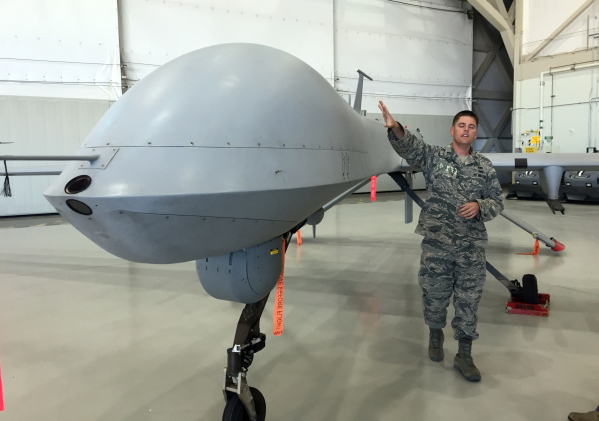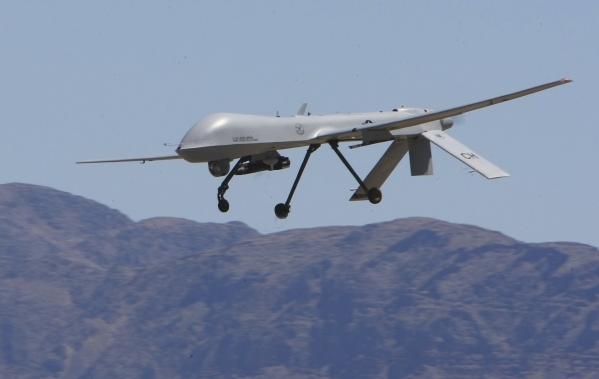Airman recounts role of Creech drones in Iraq mountain rescue


Through cameras of an Air Force Predator drone looking down on Mount Sinjar, Iraq, airmen from the 15th Reconnaissance Squadron at Creech Air Force Base watched the Islamic State assault on Yazidi people unfold a year ago.
Thousands of Yazidi men faced firing squads at the hands of the militants out to purify Iraq of non-Islamic minorities such as the Yazidis, who are neither Muslim nor Christian. Thousands more young Yazidi women became their slaves, and many still are today.
But without the help of Air Force drones armed with Hellfire missiles zooming in on the mountain where 40,000 Yazidis fled, many more trapped on the mountain would have died of thirst or hunger, according to those who participated in the humanitarian mission.
“If they came down from the mountain, they would be executed, and if they remained on the mountain, they would starve,” one pilot, Lt. Col. Ryan, said in an account released by Air Combat Command to mark the year anniversary of the mission.
For security reasons and to avoid the crew becoming terrorist targets, Creech officials would only authorize individuals for this story to speak on the condition they be identified by rank and first name only.
The mountain is about the same length of the Spring Mountains in Southern Nevada but only reaches a height of about 1,500 feet compared with the mountains east of Las Vegas that reach almost 12,000 feet.
From August through October 2014, C-17 and C-130 cargo planes dropped lifesaving supplies to the stranded Yazidis by using locations scouted by a remotely-piloted MQ-1B Predator aircraft controlled from the Creech base at Indian Springs, 45 miles northwest of Las Vegas.
In all, the airdrops provided more than 680 bundles of supplies, including 362,000 bottles of drinking water, 116,000 meals, 1,000 tents and 1,100 lanterns. Another 145 bundles were dropped at Amirili, Iraq.
Flash forward to last week’s reports of another powerful force, the Russian military, whose jets crowded the same airspace still being used by U.S. remotely piloted aircraft flown by Creech airmen in the battle against the Islamic state.
Watching from afar
From his seat behind a computer console in a ground station at Creech, sensor operator Staff Sgt. William watched the bundles being recovered through a magnified, soda-straw view from the Predator’s high-tech cameras.
Although he was nearly a half a world away, the two-second delay of the images put his eyes focused on the drop zone.
He described the so-called “remote-split” operation in an interview Thursday. In this case, an MQ-1B Predator was launched from an undisclosed location in the Middle East region. Shortly after it became airborne, the pilot-and-sensor-operator crew at Creech took control of the flight via a satellite link.
They stared at the drop zone, coordinating with special operation controllers on the ground, ready to trigger the Predator’s missiles at a moment’s notice in case enemy combatants tried to “harm any friendlies,” he said.
“We can provide eyes 24-7 on anything on the ground,” Staff Sgt. William said. “We can respond to any kind of hostile environment.”
While he said the mission “was just a normal day at work,” it did present a number of challenges, not the least of which was ensuring that the supplies wouldn’t be retrieved by the fighters from the Islamic State of Iraq and the Levant.
“Obviously there was an area of high terrain we were dealing with. We were making sure there were no enemy combatants in the area,” he said.
“The bundles hit the ground and I watched the personnel on the ground unload them, grabbing supplies,” he said.
The sight of the recovery was rewarding.
“It’s good when you get to see humanitarian aide going to people stuck in a relatively remote area,” Staff Sgt. William said, adding, “Every day I come to work it’s basically prepping for what goes on the next day.”
He said the experience “enhanced my abilities to improve on being able to see the big picture and cooperate with other assets of the Air Force and other nations to provide humanitarian aid and possible air strikes.”
Contact Keith Rogers at krogers@reviewjournal.com or 702-383-0308. Find him on Twitter: @KeithRogers2.












